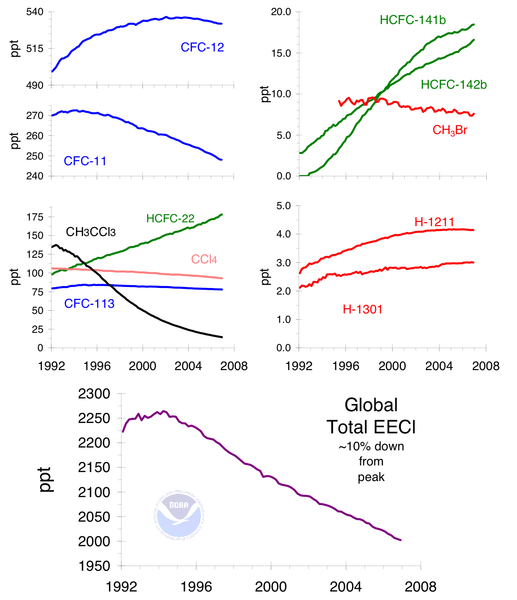Fitxer:Ozone cfc trends.png

Mida d'aquesta previsualització: 517 × 600 píxels. Altres resolucions: 207 × 240 píxels | 414 × 480 píxels | 662 × 768 píxels | 1.096 × 1.271 píxels.
Fitxer original (1.096 × 1.271 píxels, mida del fitxer: 123 Ko, tipus MIME: image/png)
Historial del fitxer
Cliqueu una data/hora per veure el fitxer tal com era aleshores.
| Data/hora | Miniatura | Dimensions | Usuari/a | Comentari | |
|---|---|---|---|---|---|
| actual | 00:00, 3 oct 2016 |  | 1.096 × 1.271 (123 Ko) | Cmdrjameson | Compressed with pngout. Reduced by 46kB (27% decrease). |
| 06:11, 6 oct 2009 |  | 1.096 × 1.271 (169 Ko) | Robert Skyhawk | Updated information current to 2008. Upload requested by English Wikipedia user Tobus2 via Images for Upload. | |
| 21:38, 15 gen 2006 |  | 1.139 × 1.577 (24 Ko) | Maksim | La bildo estas kopiita de wikipedia:en. La originala priskribo estas: CFC gas trends and equivalent chlorine effect. Combined chlorine and bromine in the lower stratosphere (10-25 km), where most ozone loss occurs, leveled off around [ |
Ús del fitxer
Les 2 pàgines següents utilitzen aquest fitxer:
Ús global del fitxer
Utilització d'aquest fitxer en altres wikis:
- Utilització a bg.wikipedia.org
- Utilització a el.wikipedia.org
- Utilització a en.wikipedia.org
- Utilització a eo.wikipedia.org
- Utilització a es.wikipedia.org
- Utilització a eu.wikipedia.org
- Utilització a fi.wikipedia.org
- Utilització a fr.wikipedia.org
- Utilització a gu.wikipedia.org
- Utilització a hi.wikipedia.org
- Utilització a id.wikipedia.org
- Utilització a kn.wikipedia.org
- Utilització a pt.wikipedia.org
- Utilització a simple.wikipedia.org
- Utilització a ta.wikipedia.org
- Utilització a zh.wikipedia.org





